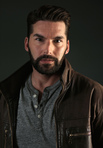Charlie David's Blog, page 10
December 20, 2020
Miss Juwanna Dewitt - inspiring community elder
Miss Juwanna Dewitt (Brian's) creative career started with Buddies In Bad Times Youth Elders Project. He followed that with MotherLoad at the 39th Rhubarb Festival. As Miss Juwanna DeWitt, his novice drag performances are best forgotten but she has risen to brighten another day! In his previous life he was hostage to lawyers, accountants and bank towers.
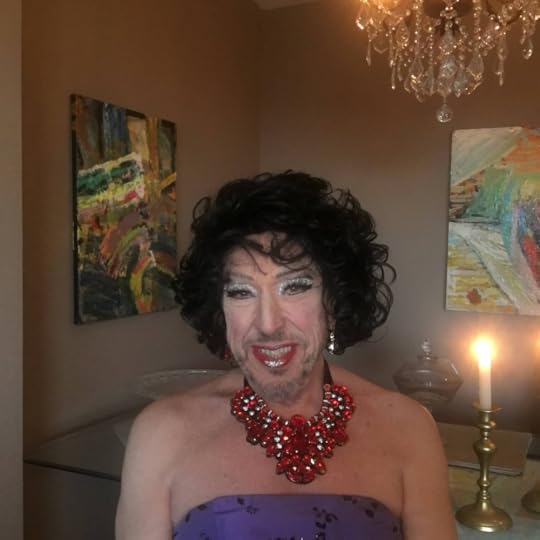
Who is your drag persona? How do they highlight or reveal parts of you in bigger and
more dramatic ways?
I am Miss Juwanna DeWitt and we are pretty much integrated. She’s a sweet and
energized lady who has a compassionate heart. She speaks her authentic truth as do I.
I would say that she is my creative self and is an expression of my desire to leave the
world a better place. Perhaps because Juwanna and I are so integrated I see myself as
more of a gender performer than a drag queen.
Does the idea of drag as therapeutic or being healing resonate with you? Why?
I applied to participate in Drag Heals to explore the theatrical work I want to expand.
Any performance or expression which is true to oneself is in some way therapeutic I
would think. I don’t think drag has any unique role in this regard. I have invested
much time over the years to address issues in my life and don’t see drag as
therapeutic personally.
How important for your health and wellness is the act of playing?
It is fundamental. I can’t imagine my life without play.
What did you discover about yourself through the Drag Heals experience?
I discovered that I had not really processed one thing I thought I had. I have spent
decades peeling back the layers of my life on my own and with many professionals. I
was more gratified to find that I am on solid ground rather than I was surprised about
any new aspect of myself.
How can the drag community benefit from being more inclusive?
Any community that breaks down walls and builds bridges will benefit in numerous
ways. Shared history, growth in understanding, bridge building, wall
destruction,compassion, understanding, reduction of judgment, opportunities to
reach out and give and the ability to be vulnerable and thus more authentic are
important benefits. The Queer community in general and the drag community in
particular is comprised of silos in my experience. Drag Heals S2 was a microcosmic
example of the benefits which come from bringing together a diverse group of artists.
Age, race, style and varied backgrounds nourished each other. We created a new
model for what can be.
https://vimeo.com/459165683
Tracey Erin Smith interviews Miss Juwanna Dewitt in Drag Heals T with T.E.S.
How would you describe your make-up and fashion aesthetic in drag?
She is evolving and has grown by leaps since the show. She’s glamorous and flashy
and loves sparkle but stays in her lane. She is more a gender performer than a drag
queen per se which means she embodies femininity which is non-exploitive nor
extreme.
What’s been most challenging about Drag Heals for you personally?
In general I wasn’t challenged emotionally or psychologically which is not to say I was
not thoroughly engaged the whole time. As the oldest artist I suppose the physical
rigours of the shooting schedule were somewhat challenging. I kept pace and
doubt/hope none of my colleagues perceived the effort.
What’s brought you the most joy?
I got the most joy and fulfillment from bringing to life a character I had played with for
many years. The audience reaction to my truth filled me with humility.
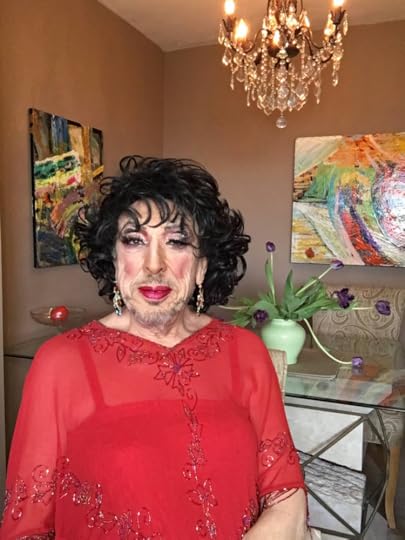
What has surprised you the most?
I undertook this opportunity for self development. I was gratified by the connections
with colleagues and the audience reaction to the live show. Other than the closing
number, I received a standing O. My rawness and authenticity touched people. As I
said “I lay it down - how one reacts is out of my hands”.
How has it been working with Tracey Erin Smith to help create your one-person show?
I enjoyed Tracey and her insights. The artists brought various levels of stage and drag
experience to the process. I had a fairly well-formed persona in mind and a
comfortable self-awareness. She was helpful in refining that and in encouraging me to
put more of myself into my personae.
What do you hope the TV audience gets out of watching Drag Heals?
I never hope for any outcome! It would be nice if audiences see the vulnerability,
effort and authenticity. And just maybe, embrace the idea of taking risks themselves
and setting aside being judgemental as a sad tool employed to feel superior.
Connect with Miss Juwanna Dewitt
Drag Heals - WoW/MoM Sasha Me
Karen Suzuki left performing to pursue film-making many years ago. She is the project manager at animation/VFX house, Electric Square Media and she produces and directs independent projects that she's passionate about.
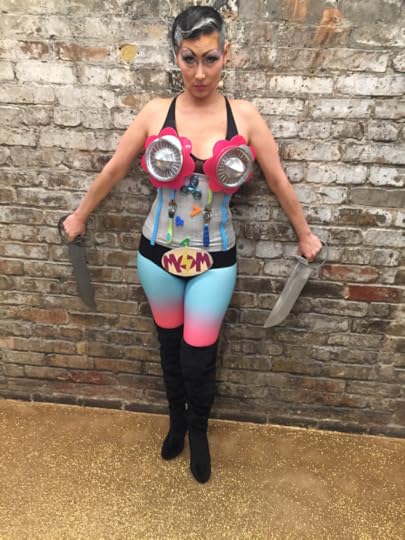
Who is your drag persona? How do they highlight or reveal parts of you in bigger and more dramatic ways?
My drag persona is Sasha Me: serving raw fish since 1974. Sasha is part Japanese, part German and all woman, just like me. Both of us are no nonsense, what you see is what you get. Sasha Me differs from me in how she takes up space and speaks her mind unapologetically. I apologize all the time and feel comfortable in a supporting role on the sidelines.
https://youtu.be/bhkSzDQuJP0How can the drag community benefit from being more inclusive?
From my point of view, the drag community is THE most inclusive community. As a cis, straight woman, I felt completely welcomed by every single person I had the pleasure of meeting on Drag Heals Season 2. But, like everything in our world right now, even the drag community can benefit from more diversity. The Drag Heals Season 2 cast was diverse in so many ways and I think the show and each of us individually benefitted from that diversity. I learned so much through the lived personal experiences of each cast, crew member and guest. It allowed me to see the true potential of drag as a spectrum of all gender expression beyond the king/queen dichotomy and more toward a monarchy. Drag is literally about walking in someone else’s shoes and it has so much potential to create empathy. So, the more diverse the community, the more powerful and far reaching the potential for empathy and understanding in its deepest form which is what we need to make real change happen.
How would you describe your make-up and fashion aesthetic in drag?
Mom ingenuity. My original reason to explore drag was to feel the fantasy of glamour and step outside of my mundane life as a middle-aged mom. But, as we began to explore drag through personal storytelling, I realized that being a middle-aged mom was precisely what made me unique as a drag performer. So, Sasha Me evolved into an unapologetically fierce mom who refuses to be ignored.
What’s brought you the most joy?
Within the short month we were together, I really felt that I understood what a drag family can be. Every cast and crew member made me feel supported and welcome. As a mom, I always put everyone else first and I keep many different balls in the air. But while I was on set during Drag Heals, I felt safe to explore, try new things and make mistakes. Every member of the cast showed me how to be brave and vulnerable and taught me how to be a better ally. I even learned to ask for help when I felt out of my comfort zone and in return, I received make up tips, choreography suggestions and costume and wig loans! It was so heartwarming. I did my best to help too, so I hope I contributed as much as I benefitted.
What do you hope the TV audience gets out of watching Drag Heals?
I hope the audience sees and understands that there is more to drag than queens and competition. Drag Heals proves that drag is limitless in its potential to explore gender expression and that is its power as an art form. The act of using yourself as a blank canvas to create something meaningful is cathartic and it takes bravery, vulnerability, and glitter. Add to that the camaraderie of a drag family and what you get is magical.
https://youtu.be/uJdmf-tzVZ8
Catch up with Karen Suzuki and her latest creations!
Nico Stagias - Director of Photography
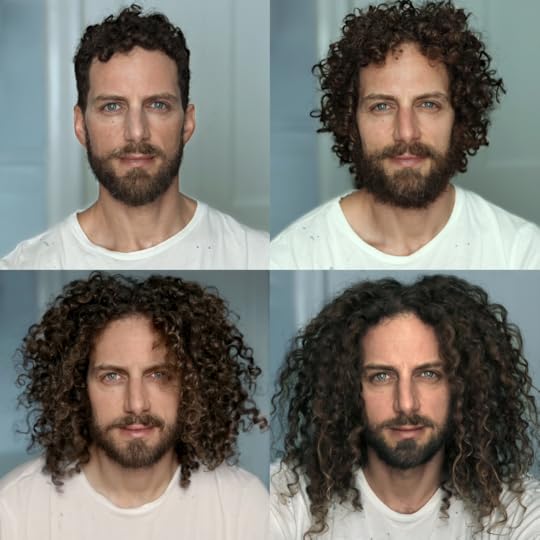
How has Drag Heals evolved from season 1 to season 2?
The production of ,Drag Heals, season 1 to season 2 has been quite a journey. As the DOP and co-producer/creator of the show, the evolution has been remarkable. Season 1 was created out of a curiosity about the work that ,Tracey Erin Smith was creating with her drag acting workshop called “Project Drag Queen”, back in March of 2016. The workshop had 8 participants looking to create one woman shows for drag queens. The B-Girls, who are a Toronto-based drag queen troupe, were mentors for Tracey’s workshop that first year. They suggested we get permission to bring cameras, and well, the rest is history. Charlie and I would show up to the workshops, one camera, a couple of microphones and record what was in from of us. For season 2, we actually had a production budget. We were able to audition a cast, hire a crew and lock down Buddies in Bad Times Theatre as our workshop and performance space. This time around, we were super excited to cast a drag show that was drag/ gender fluid. We cast ,drag kings, ,drag queens, ,drag things and ,drag monarchs. Our cast expressed a rainbow of gender/sex identities: queer, sis, trans, straight, non-binary, lesbian, gay and everything in between. I’m super proud of this series, especially the evolution of inclusiveness and diversity in our cast members from season 1 to season 2.
Why is this type of a show important now?
Drag Heals is super important because of the stories our cast is telling. A diverse expression of drag and gender identity is much needed in television. Though RuPaul’s Drag Race was revolutionary when it first appeared in mainstream television, it has not evolved in a way that has reflected the larger scope of drag performance and expression. The show mostly represents sis-gendered, queer men who are drag queens. Where are the drag kings? Where are the Drag Things, Drag Monarchs and Drag Clowns. Moreover, Drag Race is a competition show, eliminating one queen every-episode. Drag Heals is a show about celebrating a diverse group of drag artists and their process in creating a one-person show for the stage. Drag Heals is about the humility of love and supporting an artist’s process through compassion and understanding. As Tracey says, “There are no eliminations here, only celebrations!"
As the director of photography, you have an ongoing close connection with all of the talent, how do you create an atmosphere where people feel comfortable to share so honestly and freely?
The only way any human being is able to create an atmosphere of honesty is through humility and through a concerted effort to “really” listen. The reality is, I’m a privileged, sis-identified white, queer guy. I need to recognize my privilege and give space to others who have not had the opportunity nor the platform to express their perspective and their personal story. It is everyone’s responsibility, especially mine, to make space and shine a light on human diversity. Our humanity is universal, but somehow, some people don’t see that. I LOVE the cast of Drag Heals 2. They have opened my heart, opened my mind. They deserve my undivided attention and respect.
What did you discover about the power of drag in bringing a community together?
As a young, queer person studying film at San Francisco State University and the University of BC in the early 90s, I was immediately introduced to the power of drag. My first roommate in the Castro was an HIV positive, Latina drag queen with the political will to change the world. Fuji was a sexy motherfucker that did not take shit from anyone. Our friends were dying all around us, but Fuji remained steadfast. She performed for her dying community, she cared for her community and took a fierce political stance to protest against the homophobic and AIDS-phobic politicians of the day. She was a member of ACT UP and exercised her rights to protest and demand rights for the underrepresented… and in doing so, demanding rights for herself as a queer, Latina, drag queen of colour. I became politically awake. Clinton had just come into power and the world seemed to shift. Bush was gone. “Good riddance to bad rubbish”, Fuji would say. We danced and celebrated into the night as Clinton was inaugurated. Fuji helped clarify that my work as a filmmaker would tell these stories. I was driven to tell stories about the banality of gender, the injustices of homophobia, the AIDS epidemic and racism. I’ve always believed that gender is a societal construct. I dreamed of a day when gender expression was as fluid and diverse as the infinite colours of the rainbow. Once I moved to Vancouver to pursue my MFA in film, I decided then to pursue drag. Being in drag not only helped access other parts of my gender, but it also reminded me that gender is all about play. I felt liberated! I could joyfully express a part of myself that had been in the closet, even after I had come out as a gay man. As a drag queen/ clown (I was a silly queen, never passing as a “woman”), I was open and available to the world. People were attracted to Metaxia (a name I took from my grandmother) and Metaxia was more curious about the world around her, more than Nico ever was. The fear on the unknown and the fear of rejection was gone. The fear of being perfect was gone. The fear of judgment was no longer there. Drag is freedom.
What’s been most challenging about creating the Drag Heals series for you personally?
As a producer, my challenge is to make sure that no cast member is ever mis-represented. Our cast has literally “bared” their souls, their hearts to me. I take this responsibility very seriously. I am very proud of the work that we have created together, and I want ALL those relationships to continue to grow in a healthy and meaningful way. As producers, we share a fine cut with our cast to make sure they are 100% on board with their video representation. Ultimately, it’s the only way to know for sure that we are doing our job and respecting people’s stories and boundaries. Charlie and I are not interested in manipulating the words of our subjects to incite a specific, tailored reaction. We want to tell underrepresented and meaningful stories. Transparency and inclusiveness is the only way I want to create art.
Connect with Nico Stagias at www.stagias.com
Nico Stagias is a Toronto based DOP, producer and editor who has worked in television for the past 20 years. His education includes an MFA degree in Film Production at the University of British Columbia and an Honour’s BA in Communication Studies at Concordia University.
As a filmmaker/ visual creator, Nico’s achievements include 2 awards at the Inside Out Film Festival for Best Artistic Achievement in a film and Best Audience Choice Award at the Oregon Queer Film Festival. In addition, Nico’s visual elements for “TimeCode Break” (a Toronto Dance Theatre dance performance) helped garner the show a DORA Award for Best Production.
As an editor, Nico was nominated for a Canadian Screen Award for the documentary “Christopher House: Ahead the Curve”. Nico directed, produced, shot and edited over 20 promotional commercials for Nickelodeon TV. This campaign, which was shot in India, Malaysia and the Philippines, won two Silver ProMax awards for Best Campaign and Best Comedic Campaign.
Nico also partners with Border2Border Entertainment and has helped create a slew of TV series and documentaries. These DOP credits include: Shadowlands (scripted series) I’m A Stripper (doc series), PopPorn (doc series), Drag Heals (doc series), Dating Unlocked (dating show), and the following stand alone documentaries: Serviced, Sex Club 101, Into, Studlebrity, Balls, Drawn this Way, and Positive Youth.
DOP and camera credits include work on shows like: Great Canadian Cottages, Bahamas Life, Storage Wars, Canada’s Worst Driver, Don’t Drive Here, Dinner Party Wars, Four Weddings, Bump! and Keeping Canada Alive.
December 1, 2020
Nico Stagias - Director of Photography

How has Drag Heals evolved from season 1 to season 2?The production of ,Drag Heals, season 1 to season 2 has been quite a journey. As the DOP and co-producer/creator of the show, the evolution has been remarkable. Season 1 was created out of a curiosity about the work that ,Tracey Erin Smith was creating with her drag acting workshop called “Project Drag Queen”, back in March of 2016. The workshop had 8 participants looking to create one woman shows for drag queens. The B-Girls, who are a Toronto-based drag queen troupe, were mentors for Tracey’s workshop that first year. They suggested we get permission to bring cameras, and well, the rest is history. Charlie and I would show up to the workshops, one camera, a couple of microphones and record what was in from of us. For season 2, we actually had a production budget. We were able to audition a cast, hire a crew and lock down Buddies in Bad Times Theatre as our workshop and performance space. This time around, we were super excited to cast a drag show that was drag/ gender fluid. We cast ,drag kings, ,drag queens, ,drag things and ,drag monarchs. Our cast expressed a rainbow of gender/sex identities: queer, sis, trans, straight, non-binary, lesbian, gay and everything in between. I’m super proud of this series, especially the evolution of inclusiveness and diversity in our cast members from season 1 to season 2.Why is this type of a show important now?Drag Heals is super important because of the stories our cast is telling. A diverse expression of drag and gender identity is much needed in television. Though RuPaul’s Drag Race was revolutionary when it first appeared in mainstream television, it has not evolved in a way that has reflected the larger scope of drag performance and expression. The show mostly represents sis-gendered, queer men who are drag queens. Where are the drag kings? Where are the Drag Things, Drag Monarchs and Drag Clowns. Moreover, Drag Race is a competition show, eliminating one queen every-episode. Drag Heals is a show about celebrating a diverse group of drag artists and their process in creating a one-person show for the stage. Drag Heals is about the humility of love and supporting an artist’s process through compassion and understanding. As Tracey says, “There are no eliminations here, only celebrations!"As the director of photography, you have an ongoing close connection with all of the talent, how do you create an atmosphere where people feel comfortable to share so honestly and freely?The only way any human being is able to create an atmosphere of honesty is through humility and through a concerted effort to “really” listen. The reality is, I’m a privileged, sis-identified white, queer guy. I need to recognize my privilege and give space to others who have not had the opportunity nor the platform to express their perspective and their personal story. It is everyone’s responsibility, especially mine, to make space and shine a light on human diversity. Our humanity is universal, but somehow, some people don’t see that. I LOVE the cast of Drag Heals 2. They have opened my heart, opened my mind. They deserve my undivided attention and respect.What did you discover about the power of drag in bringing a community together?As a young, queer person studying film at San Francisco State University and the University of BC in the early 90s, I was immediately introduced to the power of drag. My first roommate in the Castro was an HIV positive, Latina drag queen with the political will to change the world. Fuji was a sexy motherfucker that did not take shit from anyone. Our friends were dying all around us, but Fuji remained steadfast. She performed for her dying community, she cared for her community and took a fierce political stance to protest against the homophobic and AIDS-phobic politicians of the day. She was a member of ACT UP and exercised her rights to protest and demand rights for the underrepresented… and in doing so, demanding rights for herself as a queer, Latina, drag queen of colour. I became politically awake. Clinton had just come into power and the world seemed to shift. Bush was gone. “Good riddance to bad rubbish”, Fuji would say. We danced and celebrated into the night as Clinton was inaugurated. Fuji helped clarify that my work as a filmmaker would tell these stories. I was driven to tell stories about the banality of gender, the injustices of homophobia, the AIDS epidemic and racism. I’ve always believed that gender is a societal construct. I dreamed of a day when gender expression was as fluid and diverse as the infinite colours of the rainbow. Once I moved to Vancouver to pursue my MFA in film, I decided then to pursue drag. Being in drag not only helped access other parts of my gender, but it also reminded me that gender is all about play. I felt liberated! I could joyfully express a part of myself that had been in the closet, even after I had come out as a gay man. As a drag queen/ clown (I was a silly queen, never passing as a “woman”), I was open and available to the world. People were attracted to Metaxia (a name I took from my grandmother) and Metaxia was more curious about the world around her, more than Nico ever was. The fear on the unknown and the fear of rejection was gone. The fear of being perfect was gone. The fear of judgment was no longer there. Drag is freedom.What’s been most challenging about creating the Drag Heals series for you personally? As a producer, my challenge is to make sure that no cast member is ever mis-represented. Our cast has literally “bared” their souls, their hearts to me. I take this responsibility very seriously. I am very proud of the work that we have created together, and I want ALL those relationships to continue to grow in a healthy and meaningful way. As producers, we share a fine cut with our cast to make sure they are 100% on board with their video representation. Ultimately, it’s the only way to know for sure that we are doing our job and respecting people’s stories and boundaries. Charlie and I are not interested in manipulating the words of our subjects to incite a specific, tailored reaction. We want to tell underrepresented and meaningful stories. Transparency and inclusiveness is the only way I want to create art. Connect with Nico Stagias at www.stagias.com
Nico Stagias is a Toronto based DOP, producer and editor who has worked in television for the past 20 years. His education includes an MFA degree in Film Production at the University of British Columbia and an Honour’s BA in Communication Studies at Concordia University.
As a filmmaker/ visual creator, Nico’s achievements include 2 awards at the Inside Out Film Festival for Best Artistic Achievement in a film and Best Audience Choice Award at the Oregon Queer Film Festival. In addition, Nico’s visual elements for “TimeCode Break” (a Toronto Dance Theatre dance performance) helped garner the show a DORA Award for Best Production.
As an editor, Nico was nominated for a Canadian Screen Award for the documentary “Christopher House: Ahead the Curve”. Nico directed, produced, shot and edited over 20 promotional commercials for Nickelodeon TV. This campaign, which was shot in India, Malaysia and the Philippines, won two Silver ProMax awards for Best Campaign and Best Comedic Campaign.
Nico also partners with Border2Border Entertainment and has helped create a slew of TV series and documentaries. These DOP credits include: Shadowlands (scripted series) I’m A Stripper (doc series), PopPorn (doc series), Drag Heals (doc series), Dating Unlocked (dating show), and the following stand alone documentaries: Serviced, Sex Club 101, Into, Studlebrity, Balls, Drawn this Way, and Positive Youth.
DOP and camera credits include work on shows like: Great Canadian Cottages, Bahamas Life, Storage Wars, Canada’s Worst Driver, Don’t Drive Here, Dinner Party Wars, Four Weddings, Bump! and Keeping Canada Alive.
November 19, 2020
Drag Heals - WoW/MoM Sasha Me
Karen Suzuki left performing to pursue film-making many years ago. She is the project manager at animation/VFX house, Electric Square Media and she produces and directs independent projects that she's passionate about.

Who is your drag persona? How do they highlight or reveal parts of you in bigger and more dramatic ways?
My drag persona is Sasha Me: serving raw fish since 1974. Sasha is part Japanese, part German and all woman, just like me. Both of us are no nonsense, what you see is what you get. Sasha Me differs from me in how she takes up space and speaks her mind unapologetically. I apologize all the time and feel comfortable in a supporting role on the sidelines.
https://youtu.be/bhkSzDQuJP0How can the drag community benefit from being more inclusive?
From my point of view, the drag community is THE most inclusive community. As a cis, straight woman, I felt completely welcomed by every single person I had the pleasure of meeting on Drag Heals Season 2. But, like everything in our world right now, even the drag community can benefit from more diversity. The Drag Heals Season 2 cast was diverse in so many ways and I think the show and each of us individually benefitted from that diversity. I learned so much through the lived personal experiences of each cast, crew member and guest. It allowed me to see the true potential of drag as a spectrum of all gender expression beyond the king/queen dichotomy and more toward a monarchy. Drag is literally about walking in someone else’s shoes and it has so much potential to create empathy. So, the more diverse the community, the more powerful and far reaching the potential for empathy and understanding in its deepest form which is what we need to make real change happen.
How would you describe your make-up and fashion aesthetic in drag?
Mom ingenuity. My original reason to explore drag was to feel the fantasy of glamour and step outside of my mundane life as a middle-aged mom. But, as we began to explore drag through personal storytelling, I realized that being a middle-aged mom was precisely what made me unique as a drag performer. So, Sasha Me evolved into an unapologetically fierce mom who refuses to be ignored.
What’s brought you the most joy?
Within the short month we were together, I really felt that I understood what a drag family can be. Every cast and crew member made me feel supported and welcome. As a mom, I always put everyone else first and I keep many different balls in the air. But while I was on set during Drag Heals, I felt safe to explore, try new things and make mistakes. Every member of the cast showed me how to be brave and vulnerable and taught me how to be a better ally. I even learned to ask for help when I felt out of my comfort zone and in return, I received make up tips, choreography suggestions and costume and wig loans! It was so heartwarming. I did my best to help too, so I hope I contributed as much as I benefitted.
What do you hope the TV audience gets out of watching Drag Heals?
I hope the audience sees and understands that there is more to drag than queens and competition. Drag Heals proves that drag is limitless in its potential to explore gender expression and that is its power as an art form. The act of using yourself as a blank canvas to create something meaningful is cathartic and it takes bravery, vulnerability, and glitter. Add to that the camaraderie of a drag family and what you get is magical.
https://youtu.be/uJdmf-tzVZ8Catch up with Karen Suzuki and her latest creations!
November 11, 2020
Miss Juwanna Dewitt - inspiring community elder
Miss Juwanna Dewitt (Brian's) creative career started with Buddies In Bad Times Youth Elders Project. He followed that with MotherLoad at the 39th Rhubarb Festival. As Miss Juwanna DeWitt, his novice drag performances are best forgotten but she has risen to brighten another day! In his previous life he was hostage to lawyers, accountants and bank towers.

Who is your drag persona? How do they highlight or reveal parts of you in bigger and
more dramatic ways?
I am Miss Juwanna DeWitt and we are pretty much integrated. She’s a sweet and
energized lady who has a compassionate heart. She speaks her authentic truth as do I.
I would say that she is my creative self and is an expression of my desire to leave the
world a better place. Perhaps because Juwanna and I are so integrated I see myself as
more of a gender performer than a drag queen.
Does the idea of drag as therapeutic or being healing resonate with you? Why?
I applied to participate in Drag Heals to explore the theatrical work I want to expand.
Any performance or expression which is true to oneself is in some way therapeutic I
would think. I don’t think drag has any unique role in this regard. I have invested
much time over the years to address issues in my life and don’t see drag as
therapeutic personally.
How important for your health and wellness is the act of playing?
It is fundamental. I can’t imagine my life without play.
What did you discover about yourself through the Drag Heals experience?
I discovered that I had not really processed one thing I thought I had. I have spent
decades peeling back the layers of my life on my own and with many professionals. I
was more gratified to find that I am on solid ground rather than I was surprised about
any new aspect of myself.
How can the drag community benefit from being more inclusive?
Any community that breaks down walls and builds bridges will benefit in numerous
ways. Shared history, growth in understanding, bridge building, wall
destruction,compassion, understanding, reduction of judgment, opportunities to
reach out and give and the ability to be vulnerable and thus more authentic are
important benefits. The Queer community in general and the drag community in
particular is comprised of silos in my experience. Drag Heals S2 was a microcosmic
example of the benefits which come from bringing together a diverse group of artists.
Age, race, style and varied backgrounds nourished each other. We created a new
model for what can be.
https://vimeo.com/459165683Tracey Erin Smith interviews Miss Juwanna Dewitt in Drag Heals T with T.E.S.
How would you describe your make-up and fashion aesthetic in drag?
She is evolving and has grown by leaps since the show. She’s glamorous and flashy
and loves sparkle but stays in her lane. She is more a gender performer than a drag
queen per se which means she embodies femininity which is non-exploitive nor
extreme.
What’s been most challenging about Drag Heals for you personally?
In general I wasn’t challenged emotionally or psychologically which is not to say I was
not thoroughly engaged the whole time. As the oldest artist I suppose the physical
rigours of the shooting schedule were somewhat challenging. I kept pace and
doubt/hope none of my colleagues perceived the effort.
What’s brought you the most joy?
I got the most joy and fulfillment from bringing to life a character I had played with for
many years. The audience reaction to my truth filled me with humility.

What has surprised you the most?
I undertook this opportunity for self development. I was gratified by the connections
with colleagues and the audience reaction to the live show. Other than the closing
number, I received a standing O. My rawness and authenticity touched people. As I
said “I lay it down - how one reacts is out of my hands”.
How has it been working with Tracey Erin Smith to help create your one-person show?
I enjoyed Tracey and her insights. The artists brought various levels of stage and drag
experience to the process. I had a fairly well-formed persona in mind and a
comfortable self-awareness. She was helpful in refining that and in encouraging me to
put more of myself into my personae.
What do you hope the TV audience gets out of watching Drag Heals?
I never hope for any outcome! It would be nice if audiences see the vulnerability,
effort and authenticity. And just maybe, embrace the idea of taking risks themselves
and setting aside being judgemental as a sad tool employed to feel superior.
Connect with Miss Juwanna Dewitt
November 5, 2020
Let the Kids Know - Ocean Giovanni is here!
Jay Daye (he/him) better known as Ocean Giovanni (they/them) is a 20 year old drag Monarch brand new to Toronto. Jay is originally from Nova Scotia but grew up in Ottawa and recently made the big move to Toronto to further his drag. Ocean Giovanni was born on May third when they made their debut at "Mr Chick Magnet," a local drag pageant. Going by their motto "if there's cash in the air, my black ass is there" Ocean Giovanni has been bouncing between Toronto and Ottawa to take the stage and #letthekidsknow that it's possible for a gay/trans/black person to be so comfortable in their own skin that it doesn't matter if you're wearing a wedding dress or overalls. You're perfect, you're beautiful and you better turn the damn show!
,You can show them some love on Instagram. Ocean Giovanni hosts "Category Is...' on Friday nights, a weekly online show with fellow Drag Heals cast member and friend ,Dank Sinatra.
https://vimeo.com/458742220Next time on Drag Heals episode 6, costume designer Leelando offers tips and tricks for the Drag Heals cast as they start to shape their costumes and props for their stage show.
What did you discover about yourself through the Drag Heals experience?
I discovered that I have a natural talent but that doesn’t mean I can be too easy on myself. If I don’t hone what I do, I’m wasting my gift and that’s not fair because black trans people need and deserve to be seen. My performance on Drag Heals was what I was able to do with a gentle mix of self doubt, fear and natural talent. It made me wonder how far I can go if I switch out self doubt with self love and fear for hard work. I now spend at least three hours a day putting sets together, lip syncing and dancing.
I’ll put on a TV show and lip sync what the actors are saying to make sure I can clearly separate character voices with my face and my body. I’m in dance classes, burlesque classes, learning how to sew from mentors and working hard to be able to go to acting school to round myself out. For the first time in my life, I can truly say I believe in myself. I can’t wait to inspire other people like me to invest in themselves and love themselves no matter how that may look to them.
https://vimeo.com/458743193Tracey Erin Smith spills the T with drag artist Ocean Giovanni from the Drag Heals season 2 cast.
How can the drag community benefit from being more inclusive?
The drag community would benefit from being more inclusive to a larger variety of drag because we would be able to lead people that are not in our community by example. We can’t fight for inclusivity, acceptance and tolerance if we aren’t modeling that same behaviour. Drag is already not being taken seriously as an art form and when we exclude and devalue each other's work, we’re really only hurting ourselves. Also, a cast with a mix of races, genders and intersectionality makes for a badass lineup. Why would we protest a fierce production?
What’s been most challenging about Drag Heals for you personally?
Apart from that pipe, the most challenging part of Drag Heals was allowing myself to be vulnerable. When we filmed, I was at a point where I was so focused on surviving that I couldn’t tell a scar from a wound because I was protecting everything. Working at the homeless shelter, I got used to not speaking at all. I often had to clean the male washroom and I knew that if they heard my voice and read me as gay or even transgender, it could lead me to lose my job, a world of bullying and at some points my life. I knew that the set of Drag Heals was a safe space to put my guard down, but I was scared that I would leave and forget to put it back up.
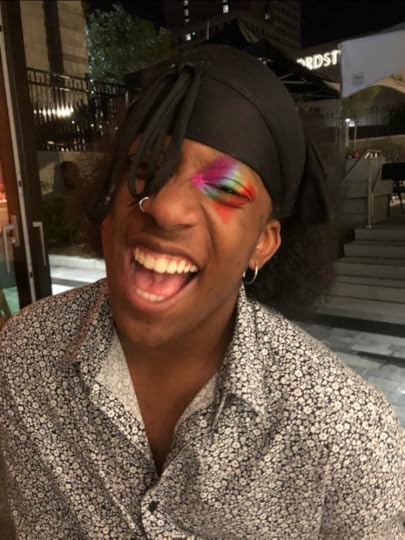
What’s brought you the most joy?
I was scared when my mom and sister drove for five hours to watch our final performances, that they would think it was a waste of their time or chock up my passion for drag as a hobby. When they both came running to me after the show to tell me how excited they were to see where else my drag would take me, I felt so validated, the most joyful feeling in the world.
What has surprised you the most?
I was most surprised to see how quickly I can transition from “Ocean” to “Jay.” I didn’t understand why people were so surprised that I have more of a laid back personality when I’m not ‘on’ because they assumed that I would be loud, extra and sassy. I knew that that’s what I often portray when I’m performing, but after watching back my episode, I realized how quickly and extremely I switch when those stage lights come on. I don’t blame people for being surprised, I shocked myself too!
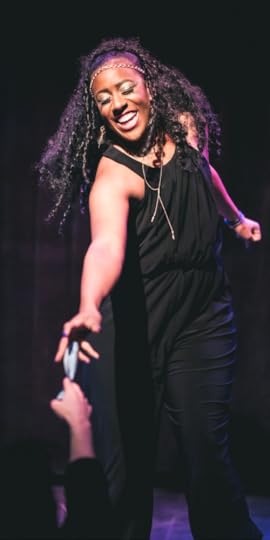
How has it been working with Tracey Erin Smith to help create your one-person show?
Working with Tracey Erin Smith was great! Having someone there that genuinely wanted my authentic voice to be heard and totally rooting for me was extremely refreshing. Tracey was there for us around the clock as both emotional and creative support. She really wanted us all to do well, and you could tell.
What do you hope the TV audience gets out of watching Drag Heals?
I hope that someone in the TV audience feels seen. I’m not saying it hasn’t happened, but in my 20 years on this earth I have never seen anyone that holds my identities on TV. DEFINITELY not a drag show. I hope that me loving my caramel mocha skin, my durag-afro puff moment and my transgender body helps others do the same.
Connect with Ocean Giovanni on
October 27, 2020
KostaMUA will scare you pretty
KostaMUA comes to the drag world via theatre and makeup. After studying and performing music theatre professionally for far more years and he cares to admit, quite by accident he fell into the make up world. After studying and graduating from Makeup and Design school, Kosta immediately began working as a makeup artist in film & television and has been lucky enough to have worked on shows such as TITANS, UMBRELLA ACADEMY, SUITS (final episode), DARE ME, GINNY & GEORGIA, and others…
Using this new medium, Kosta is taking his drag persona, SheKosta Lott, and his love of character and design and marrying them into a make up tutorial and design brand on social media platforms. Follow and subscribe to KostaMUA on YouTube, Instagram, and Facebook for Looks, clips and tutorials.
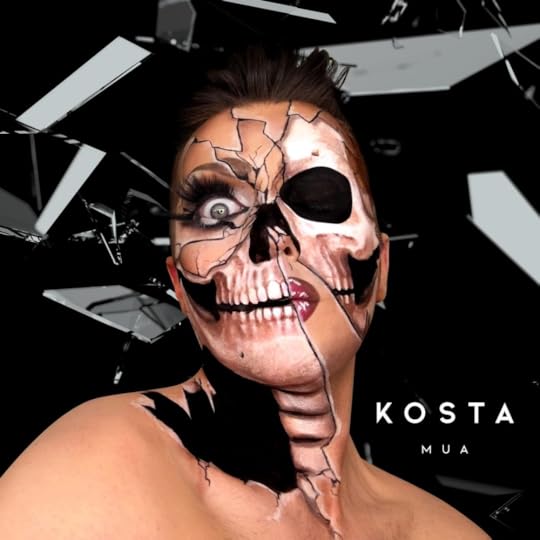
Who is your drag persona? How do they highlight or reveal parts of you in bigger and more dramatic ways?
Shekosta Lott is the one you’d see on stage. KostaMUA is for makeup related work. Both are mouthy, opinionated, brassy Broadway lovers. It’s something we have in common. Clearly. I mean, by that definition you’d have to wonder where the drag begins and I end?!
Does the idea of drag as therapeutic or being healing resonate with you? Why?
Drag has been a source of personal and professional growth. It’s given me the opportunity to embrace something beautiful, something bold, and something courageous about myself. It’s given me the voice to stand up and say, “I matter!”. I feel by allowing yourself the freedom to listen, learn, and explore the world around and within, you can only grow more rounded and happier. Shekosta Lott taught me a lot about myself and about how I interact with the world.
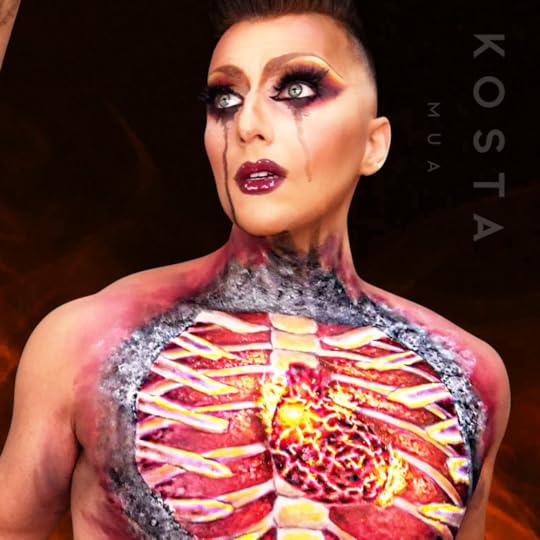
How important for your health and wellness is the act of playing?
I’m a structured person. Everything is planned and everything has its time. I am at my most uncomfortable when I don’t know who, what, when, why, where, and how … except my paints. I’ll sometimes come in with a full sketch or a plan… but I usually lose myself in the process and the next thing I know it’s 12 hours later and I haven’t taken a break. It’s in those hours where I’m happiest. Sometimes in the end there’s only a slight resemblance to the original sketch…but in almost every single case the paint is better than the sketch.
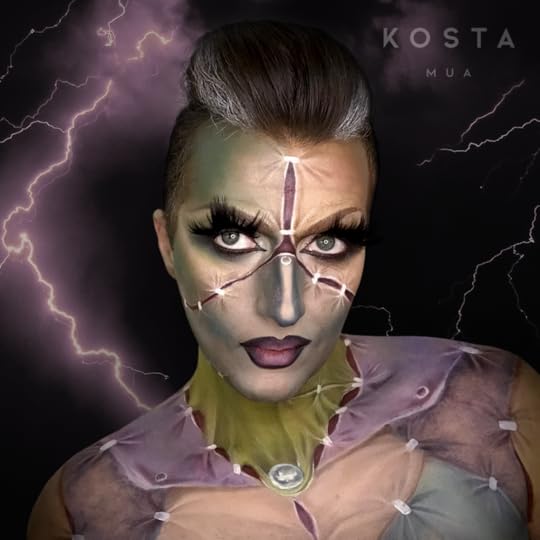
How can the drag community benefit from being more inclusive?
How could it hurt?! How could expanding the definition of something so definitively rooted in art, such as drag, be anything but a good thing?! I say let everyone do it. Let’s learn more about each other and bring in more art and more vision and more discussion. And to be frank, if you’re still holding onto some outdated notion that drag is only to be done by this type of person / should look like this / must be performed on a stage / etc… then you have some catching up to do.
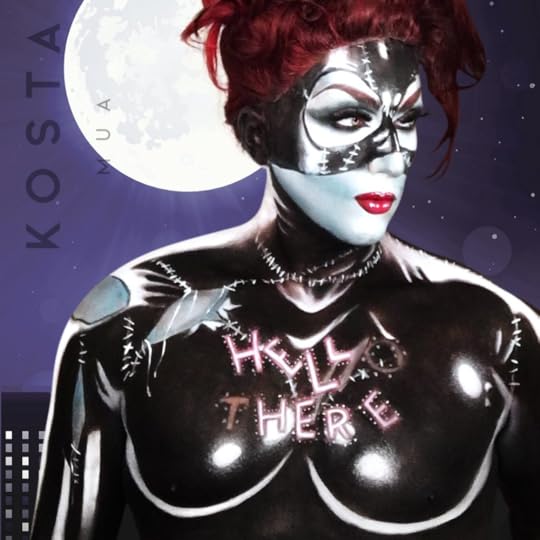
How would you describe your make-up and fashion aesthetic in drag?
At the moment I’m really into using an element of beauty and macabre through a graphic/comic style. Skulls play a massive part in my drag at the moment…as do “creatures”. I love to combine drag, theatrical, illusion, and spfx makeups into my drag. Each look is something very personal and speaks to something in my life …and sometimes it’s just to show off (I mean, let’s get real).
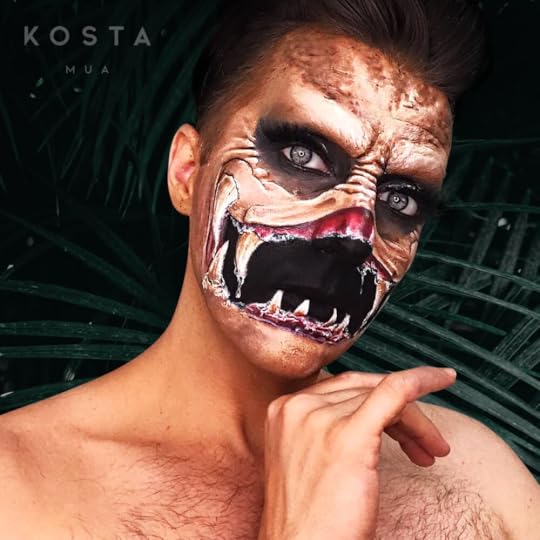
What’s brought you the most joy working with the Drag Heals cast?
What a great group of people. Really. It was clear that they were genuinely invested in each other. The communication on that set was handled warmly and with respect. As a guest it made a big difference. We had open and honest conversations about some very charged terminology and it was handled in a safe and educated way. That’s true of both the cast and crew. It was one of my better guest experiences.
What do you hope the TV audience gets out of watching Drag Heals?
Drag is hard. Drag is personal. And raw… And messy…and funny and expensive and PAINFUL and loving and draining and uplifting and…
Hard. Drag is hard.
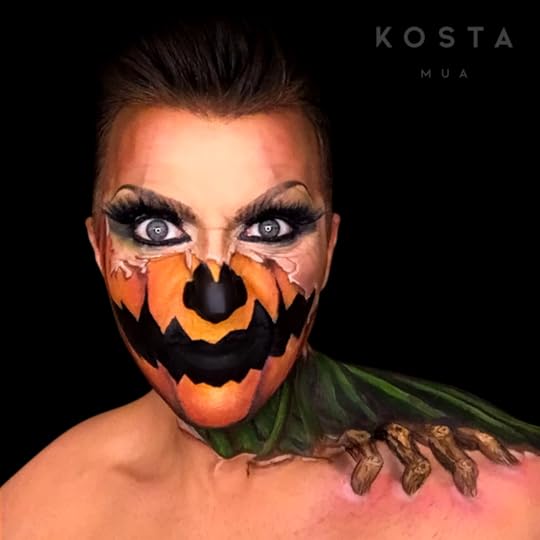
Any other topic/thought you’d like to share?
TIP. YOUR. ENTERTAINERS. GODDAMMIT!!!
Connect with KostaMUA on Instagram Facebook and www.kostahaitas.com
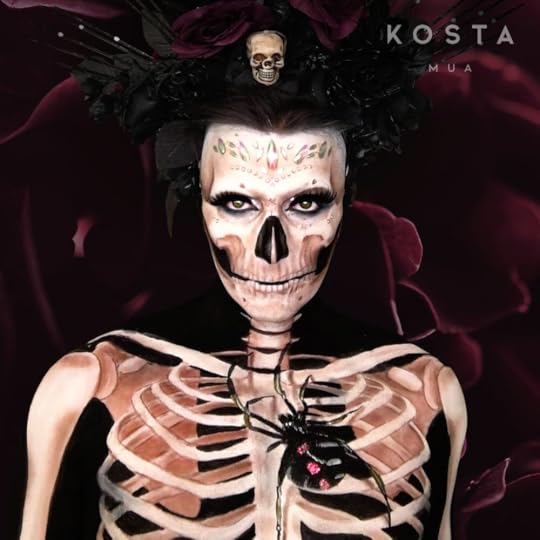
#DragHeals #Makeup
Meet Drag King Flare – Guest Coach Extraordinaire
Who is your drag persona? How do they highlight or reveal parts of you in bigger and more dramatic ways?
My base/main drag persona is Flare. The story behind my name says it all: Before coming out, before becoming a King, I was sashaying down the stairs on my way to a party when the love of my life said, “You have too much Flare to be a Clare”.
Does the idea of drag as therapeutic or being healing resonate with you? Why?
I’ve always thought it was transformative for people. When I produced The Fabulous Toronto Drag Kings I watched the experience of being in drag change people’s overall confidence, well-being, and identity. You know how it feels to see yourself in the mirror and think ‘gawd I look amazing’. Recently, including being on “Drag Heals” and hearing people’s stories, I’ve realized that if we had more/allowed ‘gender play’ into our education and upbringings we’d be a happier society. Gender play is healthy, fun, and a great way to build confidence.
,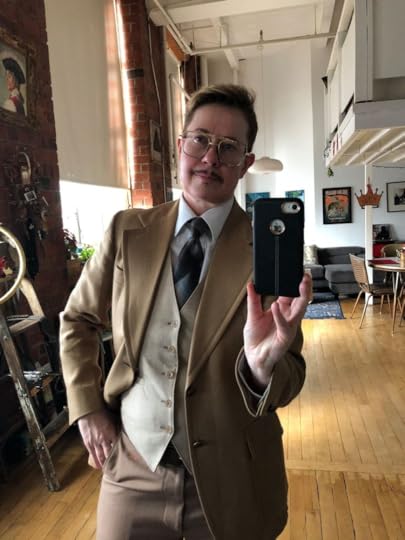
Drag King Flare has been a special guest coach for the Drag Heals series and Dude for a Day documentary
What did you discover about yourself through the Drag Heals experience?
That no matter your age, no matter your experience, you will always learn something new: and, bring tissues if you plan to be on Drag Heals.
How can the drag community benefit from being more inclusive?
We still have work to do in order to become more inclusive, which includes learning and acknowledging our history. We spend quite a bit of energy repeating steps thinking there wasn’t a brick there in the first place. Ya know. Drag King history is full of inclusive drag. It’s never talked about.
How would you describe your make-up and fashion aesthetic in drag?
Realistic character drag, always with a story.
What’s brought you the most joy working with the Drag Heals cast?
Watching the show/performances live at Buddies. Magic.
What has surprised you the most?
How much better season 2 is already!
,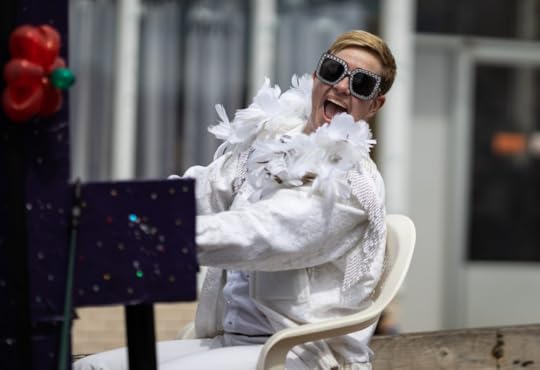
Drag King Flare has been a special guest coach for the Drag Heals series and Dude for a Day documentary
How has it been collaborating with Tracey Erin Smith to help shape the one-person shows?
Love Tracey. Learns right along with us.
What do you hope the TV audience gets out of watching Drag Heals?
I hope someone who always wanted to try drag does. I hope it inspires. Drag is for everyone.
#Drag #DragHeals #Flare
Cyril Cinder shares highlights of Drag Heals season 2
Does the idea of drag as therapeutic or being healing resonate with you? Why?
Drag has always been deeply therapeutic for me. In the other five years I’ve been performing in drag I have found so much joy, relief, and authenticity that has meant so much to me. I’m a trauma therapist and I really feel privileged to do the job that I do, but it can also be really emotionally draining some days. Drag is a major part of my own self-care routine. It lets me feel creative and express myself in a way that’s really resourcing for me, and I don’t think I could have predicted how therapeutic that would be for me when I started doing it!
,Meet Cyril Cinder in this clip from episode 5 of Drag Heals season 2
How important for your health and wellness is the act of playing?
I think one of the great loses in our society is that fact that adults are so restricted in how they’re allowed to play. We can be looked down on or shamed for being goofy and silly, and that’s so sad – it’s important to be able to let go and play! I think that drag is a way that a lot of us get around those restrictions and shame. We get up on stage as a character who is big and exaggerated, and they’re allowed to do whatever we want, and that lets us play. We should never have to feel bad for something that brings us that kind of joy, even if it might look weird to someone else.
,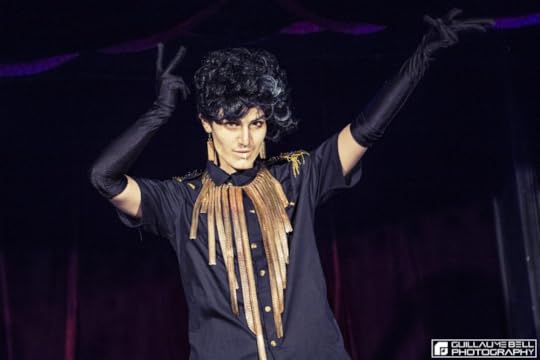
Cyril Cinder is a drag king who stars in Drag Heals season 2.
How can the drag community benefit from being more inclusive?
I think that every community benefits from diversity. A diversity of voices and experiences allows a community to grow and expand in new directions that they may not have otherwise, and I do not see drag as an exception to that rule. Including more diverse identities along the lines of gender identity and expression, race, ability, background, and styles of drag will only push the boundaries of drag further and make it better! I think that drag runs the risk of being pigeonholed into a very narrow vision of what it can truly be, and therefore stagnating, if the diversity that already exists within the community isn’t seen and respected. Drag has always existed as a way for marginalized people to demand the spotlight in their full glory and dare the audience to blink – expanding diversity and representation within the community is something that comes from the very heart of the origins of drag.
Did you second guess yourself before auditioning for Drag Heals? What made you follow through?
I was definitely nervous to audition for Drag Heals. I knew it would be an emotional process on a very public forum, and part of me was scared to be that vulnerable to anyone with an Amazon Prime or OutTV account! And at the same time, I’m in the unique position of being one of the very first drag kings on television. I felt a lot of pressure to represent drag kings as a community who are often omitted from the mainstream drag conversation. But I also knew that I was willing to put in the work, and I think that was part of why I decided to follow through. I was scared, but I was also excited by the opportunity to show what a drag king can do.
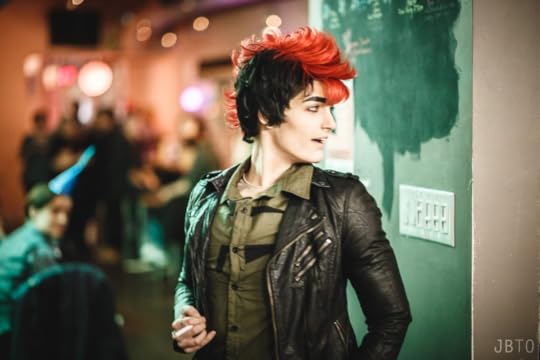
What’s been most challenging about Drag Heals for you personally?
I think one of the most challenging things for me personally about Drag Heals was the time crunch. Working full time in my private practice in Ottawa, driving the 5 hours to Toronto and back each weekend, and creating a number that was totally unique from anything I had done before was a whole new challenge for me! I can take months to create a new act from start to finish, so doing it all in one month was a lot. I also really wanted to be proud of my performance, which can be hard when you’re more than a bit of a perfectionist.
What’s brought you the most joy?
Spending the time was the cast and crew was so much fun! It was great to have these drag filled shooting days. Some of cast and guests I knew before the show, but a lot of them were new faces to me. I hope I’ve made some lifelong friends through the show!
What do you hope the TV audience gets out of watching Drag Heals?
I hope that people who watch the show are able to expand their definition and understanding of what drag is and what it can be. And that they see just how much work goes into it! There’s more than just the towering glamazon, as amazing as she is. And I also hope that people can see a bit of themselves reflected back at them in the cast, and that they’re seeing that part being loved, welcomed, and celebrated. I hope they know that they’re worthy of a good and giving life, and that they can expect more than just tolerance from themselves and others.
Connect with Cyril Cinder on Instagram and Facebook
And be sure to join our Drag Heals Facebook page to connect with all the guest coaches and performers!
,Meet Cyril Cinder in episode 5 of the Drag Heals sister series, T with T.E.S.
#CyrilCinder #dragking

